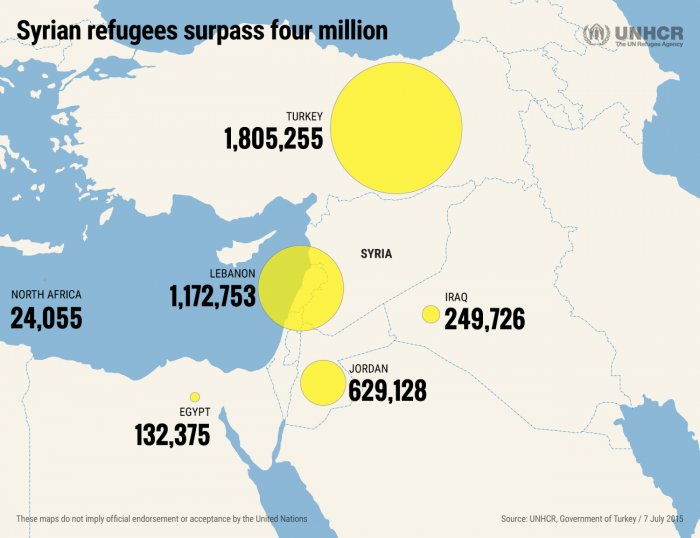Breaking Down the Status of Syria
I read a lot about Syria. This is partly because of my job, and partly because Syria lays in the middle of an area of the world that holds significant personal interest for me. Every day, I have the opportunity to dissect the many conflicting arguments and competing factors of humanitarian crises and disasters around […]
I read a lot about Syria. This is partly because of my job, and partly because Syria lays in the middle of an area of the world that holds significant personal interest for me. Every day, I have the opportunity to dissect the many conflicting arguments and competing factors of humanitarian crises and disasters around the world, and this particular one I go back to daily. So what is the status of Syria – what are the needs and the challenges – and why should anyone in the United States care?
The Needs
In three words, the urgent needs are: food, protection, health. War within Syria allowed only a small percentage of Syrians to receive food relief packages during the past several months. Agriculture production in Syria has been interrupted by the fighting within the country, along with lower than expected rainfall.
Basic protection in many areas of Syria is nonexistent. A recent report from the United Nations noted that every 60 seconds, one family in Syria is displaced due to conflict and violence. There is widespread evidence of chemical weapons, rape, and systematic torture and killing across the nation as war enters its fourth year.
The World Health Organization and the United States Agency for International Development have both expressed concern that the onset of summer, coupled with non-functioning water and sanitation systems and the lack of humanitarian access will increase the risk of a major disease outbreak in Syria. One of the major concerns is a measles outbreak – cases have been reported in 13 of 14 governorates in Syria, and it is estimated that the number of cases is greatly underreported due to the large numbers of displaced people.
The Challenges
Three central challenges are distributing relief in a war zone, the displacement of Syrians to neighboring countries, and the regional strain and unrest.
Armed conflict and government restrictions on when and how aid can be distributed makes it difficult for international non-governmental organizations to provide relief supplies to those in need. Access to rural areas is even more difficult than reaching large cities. iNGOs also face challenges in coordinating safe routes in and out of areas and ensuring the general safety of their employees.
The displacement of Syrians to surrounding nations is significant. Not only are there 6.2 million internally displaced persons in Syria, but there are millions in refugee camps in Jordan, Iraq, Lebanon, Turkey, and Egypt. Certainly the largest refugee camps housing Syrians are in Jordan (one of Jordan’s largest cities is a refugee camp), but the other four nations host large numbers of families in tent cities as well. Many of those camps are smaller than the ones in Jordan, and often lack minimal necessities. USAID estimates that approximately 3 million people are displaced to these neighboring nations. Of the 8.2 million people who were newly displaced in 2013, 43 percent of them were from or in Syria.
Regionally, this large displacement of people places a strain on these countries in a number of ways. It taxes the economy and infrastructure. Many of these countries have stability issues without adding in a large refugee population. Iraq and Lebanon have deep sectarian divides, and Egypt has experienced ongoing political unrest.
Why Does It Matter?
There are two cases to be made for response to the humanitarian crisis in Syria.
Most recently, voices in the United States have noted the growing national security concerns folded into the war in Syria. President Barack Obama, along with the director of Homeland Security, and the director of the CIA, all have publicly commented that Syria poses a security concern. Al Qaeda has taken advantage of regional unrest to establish a stronger presence. For most of the organizations we partner with at CDP, the focus is relief efforts and refugee issues, and this case for security, while strong and deserving, is muddy with foreign policy debates and political wrangling.
Indeed, the larger case for intervention in Syria is the moral case. A report from Oxford Research Group estimated that 11,000 children were killed in the first three years of conflict in Syria, and many of those were summarily executed or killed by snipers. A recent New York Times article noted comments by Tom Malinowski, assistant secretary of state for democracy, human rights, and labor, comparing Syria to Rwanda in the 1990s. I was a teenager during the Rwanda saga. Later, as an adult studying human rights in a college classroom, I wondered how so many people turned away from such a prolonged crisis with so much suffering. And I can’t help but wonder today what my sons will write about my generation’s actions towards Syria.
So that’s it – my very short breakdown on the status of Syria. A few weeks ago, a new refugee camp for Syrians opened in Jordan. Its’ name is Azraq. It’s the Arabic word for “blue” – the color associated with power, sadness, and water. Perhaps there is no better word to sum up Syria.
More like this
